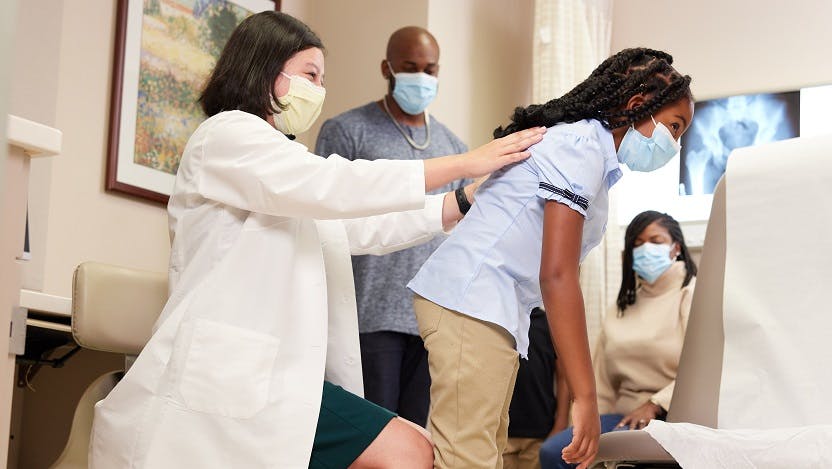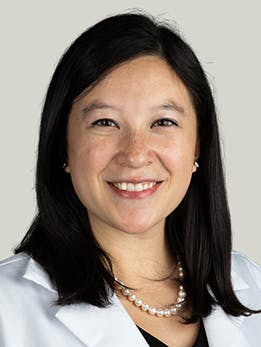Q&A: What parents need to know about pediatric scoliosis

Pediatric scoliosis is a condition in which a child’s spine, instead of growing straight, grows in an abnormal curve. With early intervention and monitoring, most cases of scoliosis in children and teenagers can be treated before surgery is needed.
Here are answers to questions parents ask about scoliosis.
What is scoliosis?
Our spines are meant to be flexible, allowing us to bend over, twist, and arch backwards. Scoliosis is a condition where the spine actually grows in a sideways curved position.
What type of pediatric scoliosis do you see most often?
The most common type of scoliosis is idiopathic scoliosis, or scoliosis that occurs for an unknown reason. This type of scoliosis occurs in a healthy child who doesn't have anything else wrong with them. Other types of scoliosis can occur due to neuromuscular conditions like cerebral palsy or genetic conditions.
At what age are children usually diagnosed with idiopathic scoliosis?
It is generally a condition of adolescence, a time when children are going through growth spurts. The curve in the spine can become much larger during periods of rapid growth, and thus become more noticeable to patients and family members.
How is pediatric scoliosis found in a child?
A lot of times it is picked up during regular checkups with the child’s pediatrician or in school screening programs. A commonly performed screening test is the Adams Forward Bend Test, where a child bends forward and an examiner looks for asymmetry in the shape of the child’s back.
In addition, parents will occasionally notice a difference in their kid’s shoulders – one shoulder is higher than the other. In athletes who swim, or have their torsos exposed, parents might notice their waist creases are asymmetric.
Other, subtle signs of asymmetry in kids’ backs can prompt referrals to us as well.
How do you treat pediatric idiopathic scoliosis?
It depends on the child. Scoliosis is really driven by growth. So, depending on how much growth a child has remaining, that helps us decide what we need to do about scoliosis. If a child is done growing and they have some scoliosis, but it’s not severe, we often observe because the scoliosis should not get worse.
When scoliosis becomes more severe, we start talking about treatment to prevent the scoliosis from getting worse. Options include bracing, which helps the spine grow a little straighter and helps stop the curve from getting larger.
If the curve becomes too large, that’s when we start talking about surgery.
How do you know how much longer a child has to grow?
We assess that based on their age, how tall their parents are, and what their growth plates look like. Another consideration for girls is the onset of menstruation. Growth generally continues for about two years after menstrual periods start.
What does bracing involve?
The most commonly used brace is called a thoracolumbosacral orthosis or TLSO. It’s a very fitted plastic brace that is custom-made for every child. It wraps around the child’s torso and rib cage. It sits at their hipbones and extends almost up to the armpits. The brace pushes on their hips and ribs to get the spine into better position.
An orthopedic surgeon will provide a “wear time” prescription that varies depending on the type of brace being used. Every second of the day, the spine grows in a better position when it’s in a brace than when it’s out of a brace.
After a period of getting used to the brace, most children find they can participate in most activities in the brace. Some activities like contact sports require brace removal because of risk of injury to other players from hitting the brace. Activities like gymnastics and dancing also require brace removal due to the lack of flexibility of the brace. Most daily activities including P.E. can be done with the brace in place.
What does surgery involve to treat pediatric scoliosis?
The most commonly performed surgery to treat scoliosis is a spinal fusion. The spine is composed of individual bones (vertebrae), stacked on top of one another. We put screws in the vertebrae that are involved in the spinal curvature and then we connect those screws with a rod, one on each side of the spine. This helps straighten out the curve and we then fuse all of those bones together so the shape of their back cannot change anymore.
After surgery, a child generally stays in the hospital between three and seven days. By six weeks after surgery, most patients feel that their energy levels have recovered and they are able to return to school. After six weeks, a child is gradually able to return to normal activities, although some restrictions (such as no sports and high-impact activities) may be in place for up to a year after surgery. In the long term, children having undergone spine fusion are able to live a full life without limitations, and complications are rare.
Can anything be done to prevent pediatric idiopathic scoliosis?
Not really. The cause of idiopathic scoliosis is likely multifactorial and avoidance of any single activity or any type of environmental exposure will not prevent it. Scoliosis does tend to be much more common in girls than boys, by a ratio of 6-to-1 or 7-to-1. Ultimately, it is most important to detect it early and as such, regular checkups with the pediatrician are vital!

Clarabelle DeVries, MD
Clarabelle DeVries, MD, specializes in pediatric orthopaedic surgery, and takes a comprehensive approach to diagnosing and treating pediatric orthopaedic conditions, including scoliosis, clubfoot, hip dysplasia and cerebral palsy. Dr. DeVries' expertise spans everything from broken bones and sports injuries to limb deformities and length discrepancies.
Learn more about Dr. DeVriesPediatric Orthopaedic Surgery
The pediatric orthopaedic surgeons at University of Chicago Medicine Comer Children’s Hospital offer comprehensive and compassionate care for children with illness or injuries of the bones, joints and muscles.
Read about our pediatric orthopaedic services